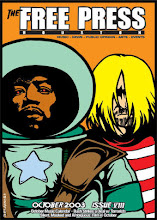The Horse Boy
A couple take their autistic son on a rest cure to Mongolia. While that one sentence synopsis explains what happens in The Horse Boy the experience as recorded by director Michel O. Scott is beyond words.
Scott has worked on films for several years in Austin, including crew positions in mainstream fare like The Texas Chainsaw Massacre: The Beginning and Kabluey both shot in and around Austin. But like all filmmakers Scott wanted to work on a project that tested his mettle.
The chance came along when Scott found himself collaborating with Rupert Isaacson who wanted to document an attempt to cure his son, or at least alleviate severe symptoms associated with autism. Issacson has a background in journalism and in fact had written books on indigenous people. One title penned by Isaacson is The Healing Land: The Bushmen and the Kalahari Desert. Issacson's wife, Kristin Neff a psychology professor, was hesitant at first but, as The Horse Boy illustrates, open to the non-conventional.
Issacson one day noticed that their son Rowan had a special relation with a grumpy mare that lived next door. There was a link between Rowan and animals that prompted Isaacson to research shamanism and horses. Mongolia, besides having shamanism as its majority religion, was also the birthplace of the domestication of horses. "We spent five to six months just on intense planning," Scott tells Free Press Houston in a phone interview.
At first Scott was going to travel with the family as a one-man film crew but a book advance for Isaacson led to enough money to boost the production budget and a three-person crew. "The film records healing in nature, healing in other cultures."
Describing Mongolia, Scott recalls that it's a huge country but the main highways that cross the land "are dirt roads." Scott utilized a Canon XHA1 high definition camcorder along with a Panasonic DVX-100 digital video camera.
The lengthy planning paid off but Scott also acknowledges a guide they acquired through National Geographic. Among the places they travel are Lake Sharga the waters of which are said to have healing powers. The images are spellbinding especially the way Scott frames the story, whether with stormy skies and mountain vistas or close-ups of the various shamans that the couple enlist. The Horse Boy opens exclusively at the Angelika this weekend.
The Horse Boy author and producer Rupert Isaacson with hold a Q&A and sign copies of the titular book at the Angelika on Saturday, September 12 following the 5:30 and 7:55 screenings.









